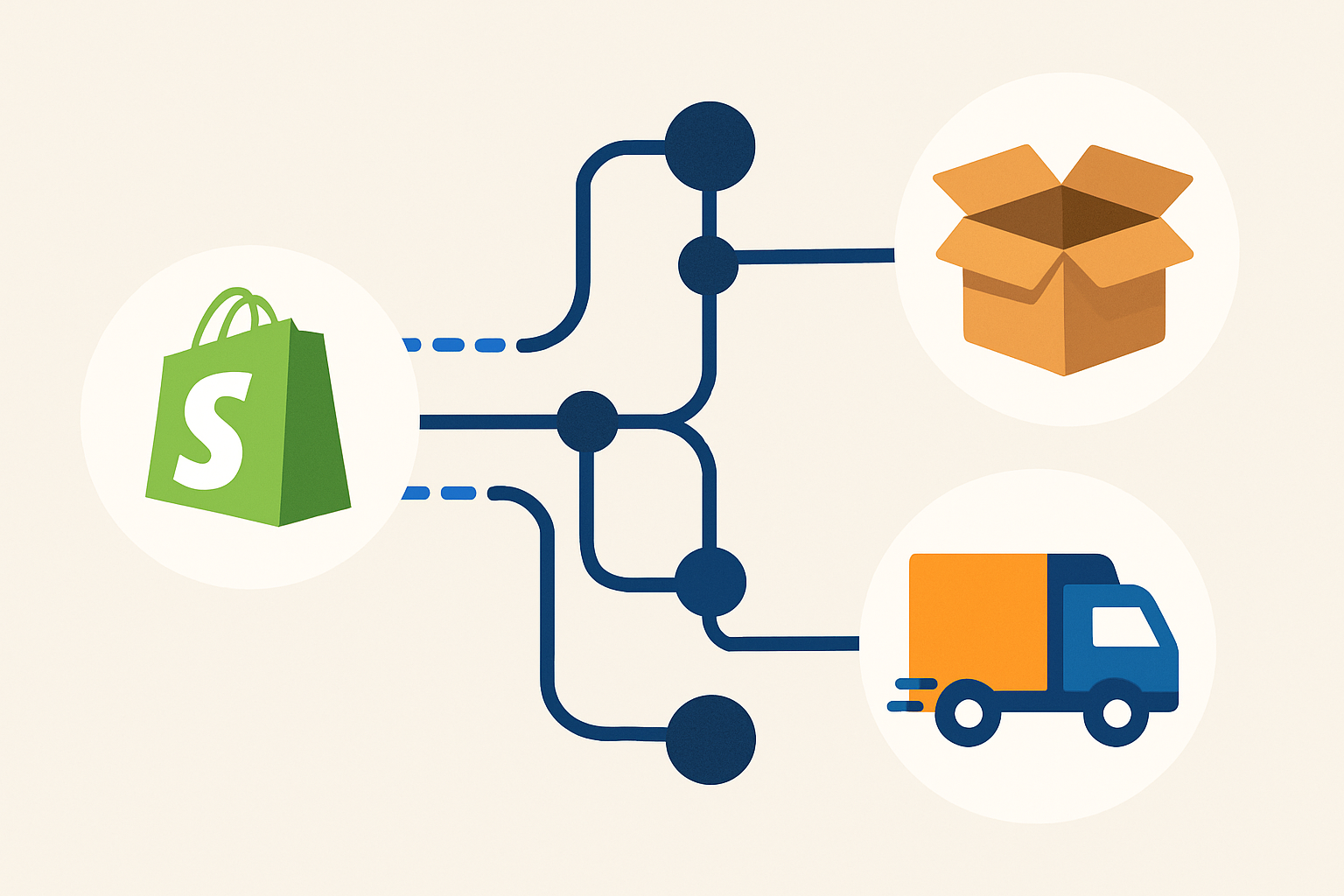Running a Shopify store can be incredibly rewarding, wouldn’t you agree? But let’s be honest, managing order fulfillment often comes with its own set of challenges. Think about it: dealing with manual processes, juggling tasks with a busy team, and watching order volumes climb higher and higher. Unfortunately, this perfect storm can sometimes lead to mistakes.
These order fulfillment errors on Shopify aren’t just minor hiccups; they can really impact your business. We’re talking about unhappy customers, the hassle and expense of returns, and potentially damaging your hard-earned reputation. In the fast-paced world of e-commerce, getting orders right, every single time, is absolutely crucial.
Did you know that the average e-commerce fulfillment error rate actually hovers between 1% and 8%? While that might sound pretty small at first glance, for a business that’s growing, that percentage quickly translates into a significant number of frustrated customers and lost revenue over time. Using n8n for n8n Shopify order automation can honestly make a huge difference and dramatically reduce these kinds of issues.
This is where workflow automation truly comes into its own, especially when using platforms like n8n. If you’re not familiar, n8n is a really powerful low-code/no-code workflow automation tool. Its visual editor is super accessible, even if you don’t have extensive coding experience. This makes it a fantastic option for small and medium-sized Shopify stores looking to make their operations much smoother and more efficient. It’s all about making your life easier and helping you automate Shopify with n8n effectively.
By putting n8n to work for your Shopify fulfillment, you unlock some pretty significant benefits. You can realistically expect to see a substantial reduction in those pesky errors, which naturally leads to improved operational efficiency and tangible cost savings. But perhaps most importantly, automating these processes significantly improves the overall customer experience. And we all know what that means: building stronger customer loyalty and encouraging those valuable repeat purchases.
I’ve seen how real-world examples show automation platforms like n8n are genuinely changing e-commerce fulfillment. Businesses are successfully using n8n to automate routine tasks like sending out order confirmations, updating tracking information for customers, and, perhaps most critically, making sure order details are correct and valid before they even get to the fulfillment stage. While the specific details of case studies are often confidential, the core principles of automating repetitive, error-prone tasks are universal. They’ve been proven time and again to yield positive results in supply chain automation.
Let’s face it, common fulfillment challenges are something many businesses struggle with: maybe a customer provides an incorrect shipping address, or an item is out-of-stock but wasn’t properly tracked, or perhaps there are shipping delays that catch everyone off guard. And sometimes, it’s even simple things like mislabeling or mixing up orders at the packing station. These issues, even if they seem minor individually, have a real, quantifiable impact.
Experts estimate that the average cost of a fulfillment error can range anywhere from $10 to over $50 per order once you factor in reshipping costs, the time customer service spends dealing with the issue, and potential chargebacks. What’s more, a surprisingly high percentage of customers – some studies suggest as high as 60% – won’t return to a business after just one negative fulfillment experience. It’s worth taking the time to understand the nuances of common Shopify fulfillment errors and their impact. Focusing on getting fulfillment accuracy right and keeping a close eye on inventory management are absolutely key to preventing these losses and keeping your customers happy.
Building an n8n Workflow for Seamless n8n Shopify Fulfillment
Okay, let’s talk about actually building an automated workflow in n8n to help catch and prevent those common Shopify order errors. It might sound a bit technical at first, but honestly, n8n’s visual interface makes it quite straightforward. We’ll walk through the main stages of setting up this kind of workflow, with a strong focus on building in solid data validation and smart error handling. This is where you truly start to make your fulfillment process a truly seamless fulfillment process with n8n, significantly improving how efficiently you operate.
The very first step when building any automation is defining what kicks it off – the trigger. For a workflow designed to reduce Shopify order errors, you naturally want the automation to begin the moment a new order is created in your Shopify store. In n8n, this means you’ll configure the Shopify node. You’ll tell it to listen for the “Order Updated” or “Order Created” event. Think of this node as the starting pistol for your workflow.
Once that trigger fires, the workflow needs to get all the details about the order. Using the same Shopify node, you’ll pull out all the relevant data. This includes the customer’s name and contact information, the full shipping address (every part of it – street, city, state, postal code), and the line items (that’s the specific product details, quantities, and prices). You can imagine this step as gathering all the necessary ingredients you need to properly process the order.
Now, here’s where things get really critical: data validation. This is the stage where automated data validation for Shopify truly shows its value.
- Address Verification: Let’s be honest, incorrect shipping addresses are a massive pain point, leading to failed deliveries and costly returns. The good news? You can easily integrate with address verification services like Google Maps API or SmartyStreets right from n8n. You’ll use n8n’s HTTP or maybe even dedicated service nodes for this. The workflow sends the extracted shipping address details to the service, and it sends back a validated, standardized version, or it flags the address if it’s invalid. This is automatic shipping address validation n8n makes simple. For example, you’d send the address components (like street, city, zip) to the service and get back a corrected address or a clear validation status (something like “valid,” “invalid,” or “requires review”). The cost for these API calls is usually just pennies – a tiny investment when you compare it to the real cost of a failed delivery.
- Inventory Check: Nothing frustrates a customer more than ordering something only to find out it’s out of stock. To prevent this, you can integrate n8n with your inventory management system. If you don’t have a separate system, you can even query Shopify’s product data directly if that’s where you keep track of everything. Before your workflow proceeds to fulfillment, it checks if the quantity requested for each item in the order is actually available. If it’s not, instead of sending a doomed order to fulfillment, the workflow can flag it for manual review.
- Format Standardization: Data, bless its heart, can come in all sorts of shapes and sizes! N8n’s data transformation nodes are perfect for this. They let you standardize formats. For instance, you can make sure all phone numbers are in the exact same layout or ensure postal codes match the specific structure required by your shipping carrier. This cleaning process using data transformation really helps reduce errors further down the line when you send this data to other systems. You might use expressions within n8n to reformat a phone number string or convert data types from one format to another.
Designing how your workflow handles errors is honestly just as important as the validation itself. What should happen if an address is flagged as invalid? Or if there isn’t enough inventory for an item? You can use n8n’s “If” nodes to create different paths or branches in your workflow based on the results of your validation steps. If the data is invalid, instead of just pushing it through to fulfillment, you could use a notification node (like sending an Email or a message to Slack) to immediately alert an administrator or your team for manual review. “Try/Catch” nodes are also super helpful for catching unexpected errors that might occur, say, during an API integration or a complex data processing step. This prevents your workflow from simply failing silently – proactive error logging is truly vital.
Next up, you’ll integrate with whichever fulfillment service you use (maybe ShipStation or EasyPost). You can do this using their specific n8n nodes, if available, or use generic HTTP requests for API integration if they offer a public API. If all the validation checks pass with flying colors, the workflow automatically sends those clean, verified order details over to your fulfillment system. This triggers the shipping process without anyone having to lift a finger for manual data entry, which, as we know, is a common source of errors. If you want to see a practical example, you can explore an automatic Shopify order fulfillment workflow template on n8n’s website.
Finally, once the order has been successfully fulfilled and shipped, the workflow can automatically update the order status back in Shopify using the Shopify node again. This creates a nice closed loop. It keeps your Shopify store’s order data accurate and completely up-to-date without any manual effort. Automating these validation steps can save your team a significant amount of time – potentially several minutes per order – which really adds up, especially during busy periods like holiday seasons.
One piece of advice I always give: remember to test your n8n workflow thoroughly using test orders before you even think about letting it handle live ones. Start by testing a few different scenarios. Include perfectly valid orders, but also test orders with obviously incorrect addresses and orders that contain items you know are out-of-stock. This way, you can be sure your error handling is actually working exactly as you expect it to.
Advanced n8n Techniques for Maximizing Error Reduction
Once you feel comfortable with the basics of building workflows, you can start diving into some more advanced n8n features. These techniques can really help you make your Shopify order processing even more robust and significantly more resistant to errors. We’re talking about going beyond simple checks and introducing more sophisticated logic and deeper integrations.
Implementing complex conditional logic is one way to make your workflow capable of handling almost any scenario automatically. You can use multiple “If” nodes chained together or the “Switch” node to route orders down different paths based on specific criteria. What kind of criteria? Well, you could route based on the order’s total value (is it a large order that might need extra verification?), the shipping country (do you need to handle international orders differently?), or even based on specific products included in the order (maybe flag high-value or fragile items for special attention). This level of customization ensures that every single order gets the appropriate level of scrutiny based on your business rules.
Those data transformation nodes I mentioned earlier? They are incredibly versatile! They are fantastic for cleaning up and standardizing data that might be coming from various sources before you send it off to other systems. It’s not just about simple format changes. You can use them to map data fields between systems that use different terminology, combine information from multiple places, or even perform calculations on your order data. This ensures that data consistency is maintained across your entire supply chain automation setup.
Integrating with external APIs can also greatly enrich your order data and provide extra layers of error prevention or verification. For example, you could integrate with fraud detection services to automatically flag any orders that seem suspicious. Or, you could connect to customer segmentation tools to automatically add tags to orders based on a customer’s purchase history or status. These integrations, often done via HTTP requests or sometimes dedicated nodes, can provide almost predictive analytics capabilities, helping you identify potential issues much earlier in the process.
Scheduled workflows offer another layer of data integrity checking. While trigger-based workflows (like the one that starts when a new order comes in) handle real-time events, you can set up a separate scheduled workflow to run daily or weekly. What does this workflow do? It can check *existing* open orders in Shopify for any inconsistencies that might have somehow slipped through your initial checks. This could be orders that seem stuck in a certain status or maybe are missing crucial bits of information. This kind of anomaly detection is really helpful for catching errors retroactively before they cause bigger problems.
N8n’s expression editor is a particularly powerful tool if you need to do complex data manipulation or build intricate conditional logic. You can write JavaScript-like expressions to perform calculations on your data, manipulate text strings (like formatting names or addresses), or build really intricate conditions based on any part of your order data. This allows you to create highly customized workflows that are perfectly tailored to your unique business requirements. For instance, you could write an expression that calculates a specific handling fee based on the order weight *and* the destination country combined.
It’s important to remember security when you’re handling sensitive customer data within your workflows. Security considerations are absolutely paramount. Always make sure you are using secure connections (HTTPS), storing any credentials safely within n8n’s built-in credential manager, and limiting access to your n8n instance itself. Good practice for secure data handling involves minimizing the amount of sensitive data stored in your workflow execution history and, of course, complying with any relevant data protection regulations in your region.
Finally, monitoring and maintaining your n8n workflows isn’t a one-time task – it’s ongoing. Make good use of n8n’s execution logs to review how your workflows are running, quickly identify any errors that occur, and troubleshoot issues. It’s also wise to set up notifications so you’re immediately alerted if a workflow fails to execute. Regularly review and update your workflows, especially as your business processes change or if the integrated services you use update their APIs. Proactive maintenance is key to preventing potential errors before they even have a chance to impact your orders. By implementing advanced error handling techniques using these methods, you can significantly reduce the need for manual intervention, freeing up your team’s time and truly improving data quality across the board. If you ever get stuck or need expert help, finding an n8n expert in the community or via a partner can be incredibly valuable.
Unlocking a Seamless Future for Shopify Order Fulfillment
We’ve covered a lot of ground, looking at how using n8n for Shopify fulfillment error prevention can really change the game for your fulfillment process. By automating those crucial steps like data validation and handling potential errors automatically, you make a huge leap in improving fulfillment accuracy. And that, in turn, leads directly to a noticeable reduction in common problems such as sending out incorrect shipments or having to notify customers about out-of-stock items. This, naturally, makes for dramatically happier customers.
But the benefits don’t stop at just having happy customers. Fewer errors mean fewer returns to process, lower costs associated with reshipping items, and less time your customer service team has to spend dealing with complaints and fixing problems. All of this directly translates into real, tangible cost savings and makes your business operations much more efficient. An automated process, especially one powered by a tool like n8n, cuts down significantly on manual workload and speeds up the entire process from the moment an order is placed until it’s fulfilled and shipped.
One of the things I really like about n8n is its scalability. As your Shopify store continues to grow and order volumes inevitably increase, your n8n workflows are designed to easily handle that increased load. You can duplicate workflows, scale up your n8n instance if needed, and adapt your automation to meet changing fulfillment requirements without needing to suddenly hire a huge team just to keep up with manual processing. This flexibility is absolutely key for digital transformation, especially for businesses that are expanding rapidly.
If you’ve reached a point where you’re ready to stop letting fulfillment errors hold back your Shopify store’s potential, now really is the perfect time to explore n8n. Their documentation is extensive and incredibly helpful, and they have a vibrant community forum where you can find answers and help. Definitely check out their Shopify integration page to see just how straightforward it is to connect the two platforms.
As a practical next step, I’d suggest setting up a test environment for both n8n and your Shopify store. This way, you can experiment with building and running workflows without any risk of affecting your live orders or customers. If you run into particularly complex scenarios or need some specific guidance tailored to your business, remember that consulting with an n8n expert or partner can provide invaluable support.
Implementing n8n workflows for Shopify fulfillment error prevention isn’t just about fixing existing problems; view it as a smart investment with clear potential for a strong ROI. By reducing costly errors like chargebacks and minimizing the time spent on manual rework, and by improving customer retention through positive fulfillment experiences, you are directly impacting your bottom line and the lifetime value of your customers. Even projecting the cost savings over a year based on just a modest reduction in your error rates can reveal some pretty significant financial benefits. Why wait? Start automating your Shopify order fulfillment process today and take a big step towards a future of smooth, error-free operations and continuous improvement.



